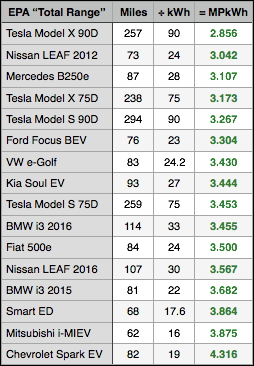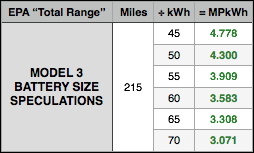As we all know, miles-per-kWh is the key factor to speculate about battery size and range. Perhaps it would be helpful to compare the MPkWh of the current EVs on the market. This table lists the EPA results, lowest to highest:
I have no doubt that owners routinely achieve higher MPkWh than the EPA ratings. After all, I have averaged 5.4 MPkWh in my Nissan LEAF after 4 years, significanty higher than the 3.042 in this table. Regardless, since Musk claimed that the base Model 3 will have a
EPA range of 215 miles, this is the measuring stick we should use to calculate reasonable speculations. Here are the results with different sizes of battery packs:
What the table suggests is that, to achieve an "EPA Total Range" of 215 miles with a 50 kWh pack, the Model 3's MPkWh would have to approximate that of a Chevy Spark EV. And with a 55 kWh battery, it would have to exceed that of a Mitsubishi i-MIEV.
Is it possible to extract such a high level of energy efficiency from the pack? Perhaps, but I have my doubts. Given the size of the Model 3, my own guess is that its MPkWh will likely be similar to those for the Nissan LEAF and the BMW i3 above --which would necessitate... a 60 kWh battery pack. Anything less would require a much lighter battery and an impressively slick drag coefficient. Only time will tell if Tesla can pull that off.






